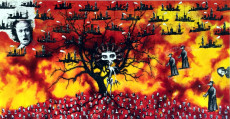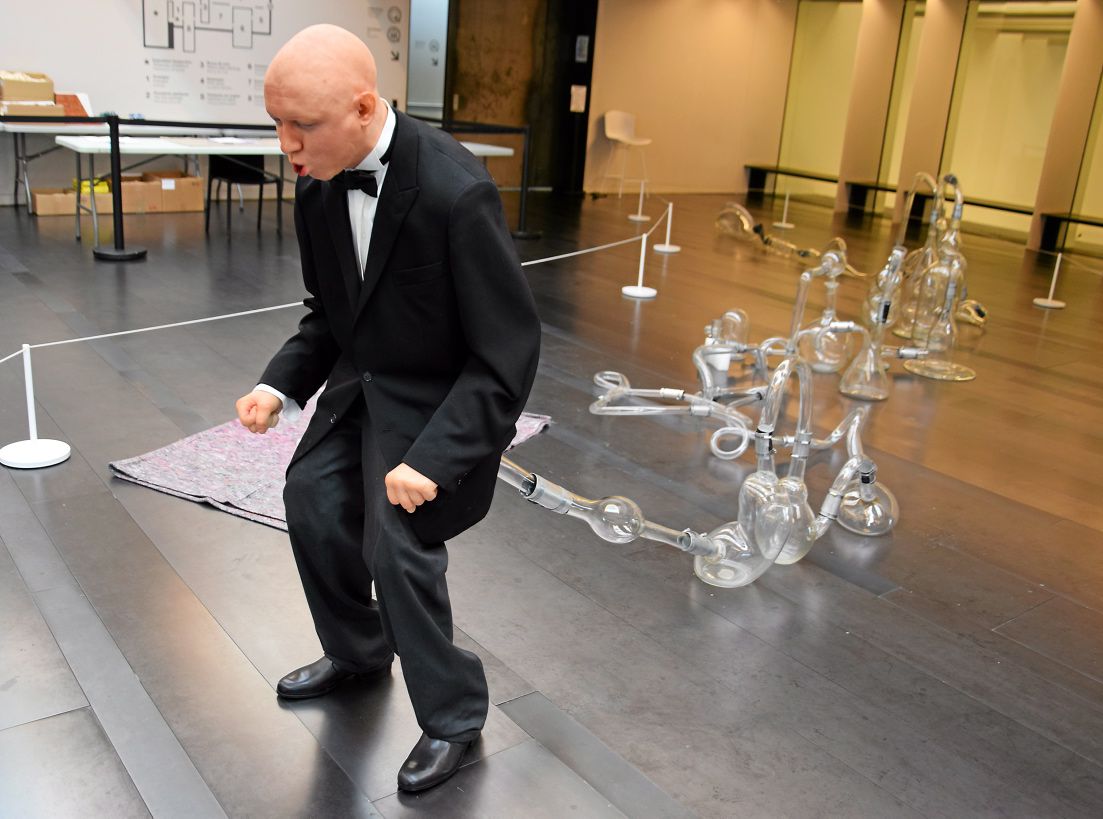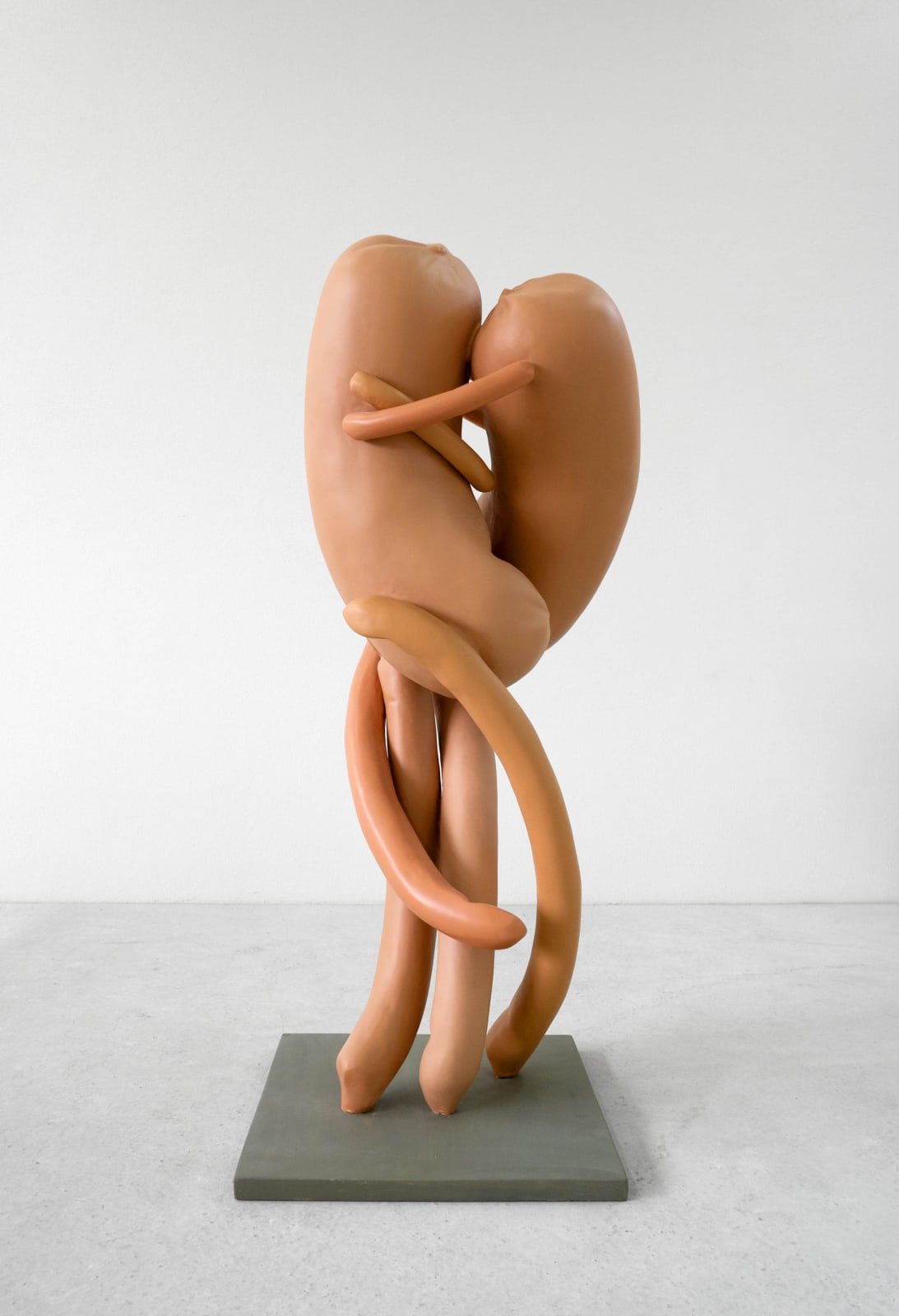
Humour and love of art

About this month's dossier on the funniest works of art.
It's funny. In his editorial for the June issue of Beaux-Arts Magazine, Fabrice Bousteau claims the right for art to be funny. The right not to be labelled vulgar, stupid or ridiculous when it makes people laugh. But he also explains that he could not put on the front page of the magazine a photo of a work such as Gilles Barbier's "Orgue à farts", which he considers extraordinary, or Erwin Wurm's "Big Kiss", whose two sausages he considers hilarious. And why? Because this kind of cover would probably have prevented the issue from being bought at the newsstand.
|
"Organ with farts" by Gilles Barbier |
"Big Kiss" by Erwin Wurm |
So how do we defend the humour of art to those who love art? We trick them into publishing a fascinating and well-documented dossier, but we announce it in the headline with the 'too cute' red teddy bear by the Italian artist Paola Pivi, which initially makes them smile instinctively and blissfully. And above all, we don't risk losing money.
In the caption to the photo that appears on the opening double page of the dossier devoted to the "funniest works in history", a beautiful pair of very expressive buttocks, the journalist Daphné Bétard makes it clear that they are "not always classy but always effective, The images of TOILETPAPER, the magazine founded twelve years ago by Maurizio Cattelan and the photographer Pierpaolo Ferrari, with their pop, acidulous and offbeat aesthetic," and that they "hit the nail on the head, awakening our most secret impulses. Because, after all, we shouldn't laugh too much: art must have something serious to say...
If humour and art have always gone hand in hand, from the orgiastic paintings of the Middle Ages to today's hijackings on Instagram, which journalist Florelle Guillaume wonders at the end of the dossier if it has not become the humorous form of the 21st century, the sometimes slightly potty pairing remains no less subversive... and enjoyable. Often very poetic too, as shown by Marcel Mariën's "L'Introuvable" (1920-1993), this eyewear for a cyclops with a deliciously useless little head, imagined by the Belgian surrealist. But the free union of art and comedy is perhaps even more often born of the desire to provoke, applying itself very early on in the history of art to give a kick to the anthill of morality and religion. And Daphné Bétard quotes the beautiful book by Francesca Alberti, published in 2015 by Actes Sud, "Peinture facétieuse", to illustrate her point with a few well-chosen examples. Like the swelling of the cloth tied around the hips of Saint Sebastian in front of the Madonna in the devotional painting by Correggio, an oil painting on wood dating from around 1524, or the staging of a real vaudeville by Tintoretto in "Venus, Vulcan and Mars", an oil painting executed around 1550-1555. Not to mention the countless nifty details that are always to be found in the paintings of Bosch and Bruegel!
Paintings, drawings, sculptures, installations, videos... humour makes its way into all works of art. In 1883, Jules Lévy, the founder of the Incohérents, a group of merry pranksters who wanted to shake up the Parisian art scene, said: "Seriousness stultifies, gaiety regenerates". The aim was to make people laugh by all means, and many artists of the late 19th century, such as Alphonse Allais, Eugène Bataille and Toulouse-Lautrec, were cheerfully amused by this and competed in puns under pseudonyms such as "Zipette", "Sapeck" or "Troulala". This movement was as crazy as it was short-lived, but it paved the way for a 20th century of avant-gardes full of poetic-contest and nihilistic delirium, hilarious diversions, and tragi-comic counter-culture... Until Fluxus took over in the 1960s, and this "non-movement", which had become a champion of anti-art, ran rampant for thirty years.
Today, laughter still galvanises the unbridled imagination of artists such as Gilles Barbier, Erwin Wurm, Maurizio Cattelan, Sarah Lucas, Paul McCarthy, Laure Prouvost or Mika Rottenberg, but we cannot say that their works of art are funny. We shouldn't exaggerate. Burlesque, crazy, trashy, silly and nasty, sophisticated, cruel... yes. Committed, flabbergasting, derisory or cathartic... yes. But it always comes down to the same thing: "their works are all stimulating for the eye and the mind" concludes Daphné Bétard. Because, like art, humour is never useless. And the degrees of interpretation are made to multiply.
In four sections entitled "Funnily realistic", (or when hyperrealism is used as a visual gag), "Effectively trashy", (or when the trampling of good taste and propriety refers to the triviality of the world), "Absurdly beautiful", (or when delirious poetry makes the strangeness of the world irresistible), and "Deliciously twisted", (or when surrealist diversion never ceases to make emulators), the journalist then unrolls a joyful ribbon of works of art from which to pick up something to laugh at and to think about, something to take the high ground or the high seas.
For example, this Lilliputian man sweeping a giant kitchen, lost in a world too big for him, imagined by the artist Jean-François Fourtou, which first makes you smile before plunging into a deep feeling of powerlessness. Or this cigarette slipped into the buttocks of a sculpture by Sarah Lucas, a crude nose-thumbing at the viewer, whose fat, embarrassed laughter one immediately imagines. Or these two policemen leaning against a wall... upside down. A sculpture in resin and wax created by Maurizio Cattelan to express that despite the serious pose befitting their function, arms crossed or weapon in hand, these two men charged with discerning truth from falsehood see the world upside down. But a sculpture whose human size can only make the visitor laugh when he suddenly finds himself face to face with it.
And what about designer Kenji Kawakami's "Q- hat", Fabrice Hyber's "double-edged car", Erik Dietman's chairs with a cactus for the fourth leg, Philippe Ramette's suspended man, or Jim Shaw's strange hair ghost? A lot of things! Enough to fuel a few conversations in any case. With a special mention, if you are sensitive to poetry, for Roman Signer's work entitled "






































































